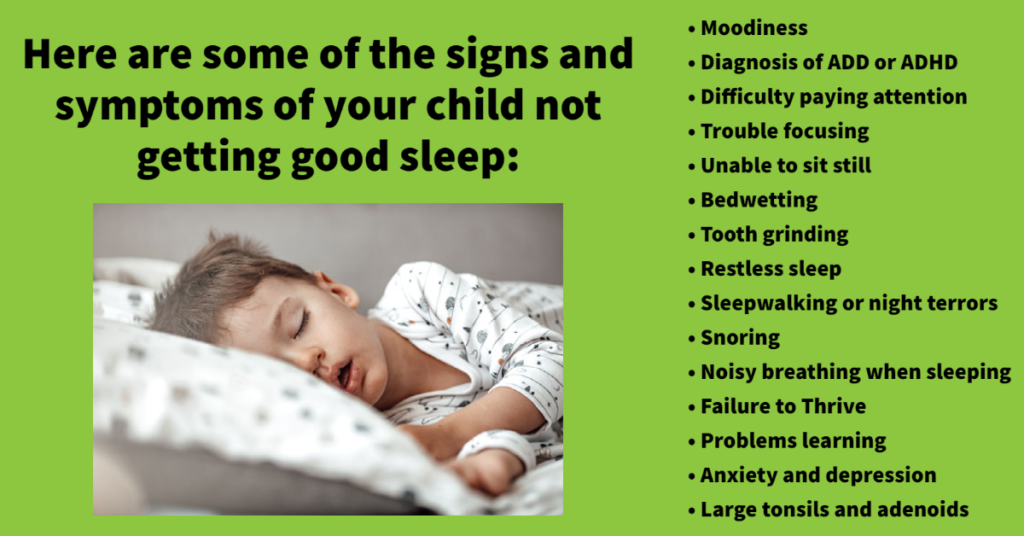Guest Blogger: Kyle Isaacs, Mouth Breathing and Sleep Issues

How well do you sleep? What about your child/children? Parents of young children often get by on less sleep or interrupted sleep when their children are little. This can be tough, to say the least! Functioning with the day-to-day happenings can be stressful, and patience can be super thin when you don’t get enough quality sleep. Maybe you feel groggy, or your brain feels foggy. No one can function long-term this way, and life is more enjoyable when we are rested and recharged. The same goes for kids! They thrive when they get the proper amount of quality sleep. Overall, they are more pleasant to be around, do better in school, and have normal growth, not to mention they are healthier when they get quality sleep.
How do you know if your child is sleeping well? Are they quiet, or do you hear them breathing loudly, snoring, or even grinding their teeth? Maybe they are restless, sleepwalk, or wet the bed. Even if you and your kids sleep through the night, this does not necessarily mean that you are getting restorative rest. When sleep is disrupted, it often goes unnoticed but can have drastic health and behavioral effects. Does your child have any behavioral issues? Maybe you have taken them to a variety of professionals without results or even started them on medications. Often mouth breathing is a huge factor in sleep issues and increases the risk for a whole host of problems.

Usually, people who have sleep issues are mouth breathers. Kids who are mouth breathers are more likely to have sleep apnea when they are older. Generally, people are unaware if they are mouth breathers; it might be because they are so used to breathing that way that they do not know any other way. I often ask my patients if they breathe through their mouth and the majority say no, even if I see evidence of it. During the day, it is easier to compensate and make a point to breathe through the nose, but with sleep, muscles in the back of the throat relax, and the tongue, soft palate, and other tissues fall back. This is when the airway becomes closed, making mouth breathing the only option. Mouth breathing inflames the tonsils and other soft tissues in the mouth and often creates congestion in the nose. When the nose is congested, more mouth breathing occurs, then more congestion, and it is a vicious cycle.
Mouth breathers often get more cavities and are more likely to have periodontal (gum) disease than nose breathers. The tongue will be sitting low in the mouth and not helping to shape the palate. Both the upper jaw (maxilla) and lower jaw (mandible) will likely be underdeveloped, leading to crowded teeth and a narrow palate, further making the nasal cavity smaller, making it even harder to use the nose to breathe.

Mouth breathing is not normal and not healthy, even though it might be common. Nose breathing is slower and more relaxing, and it warms and filters the air we breathe. It also increases nitric oxide, which is important for our immune system, and it helps deliver more oxygen to other parts of the body. Mouth breathing is faster and causes that “fight or flight” feeling. Over time, children who are mouth breathers will likely have interrupted sleep, affecting growth, hormones, and normal development. Research shows sleep disturbances can increase structural changes in the brain and thinner gray matter. This is important because thinner gray matter has been shown to increase behavior issues.
So how do you know if your kids have problems getting quality sleep?

So how do you know if you or your child has sleep issues? As a first step, you may want to visit a sleep specialist who is well versed in airway issues. The specialist may recommend having a sleep study or test. I highly recommend making a short video of your child sleeping that shows their mouth open, noisy breathing, snoring, etc., to share with the doctor. For kids, seeing an ENT to have their tonsils and adenoids checked is also helpful.

Your child may need to see an orthodontist for possibly expanding the jaws as well as a myofunctional therapist for doing exercises to help strengthen the muscles of the face and tongue and to learn how to breathe with the nose, how to swallow correctly, how to have the tongue on the roof of the mouth all the time, and how to maintain a closed lip posture. The facial and tongue muscles are often weak, making it more challenging to reach those goals, and with specific exercises, they can be strengthened and toned. When our tongue is low in the mouth and we are mouth breathing, we will compensate with other muscles increasing the risk for chronic pain, headaches, TMJ discomfort, and more. A myofunctional therapist can also evaluate the lingual frenum (muscle attachment under the tongue) for a possible tie or restriction and make referrals for an evaluation by a tongue tie doctor.
By: Kyle Isaacs, RDHEP, BHS, Community Health Centers of Benton & Linn County
More information and resources:
American Academy of Physiological Medicine & Dentistry
Finding Connor Deegan (one parent’s journey with a child with disordered breathing)